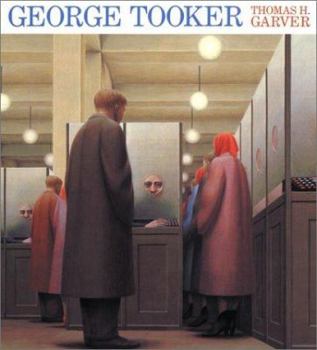George Tooker
Select Format
Select Condition 
Book Overview
This Reprint Contains Over 150 Paintings of George Tooker. The color reproductions capture the luminous quality of the artist's work in egg tempera, and his meticulous painting technique is described... This description may be from another edition of this product.
Format:Paperback
Language:English
ISBN:1566400686
ISBN13:9781566400688
Release Date:January 1992
Publisher:Pomegranate Communications
Length:164 Pages
Weight:2.22 lbs.
Dimensions:0.6" x 10.0" x 11.0"
Customer Reviews
3 ratings
masterful, sensitive paintings of angst in modern society
Published by Thriftbooks.com User , 16 years ago
A portal onto George Tooker's unsettling paintings is a 1997 New Yorker cartoon by Tom Cheney titled Skeleton in Cubicle. In the middle of a group of nine office cubicles is a skeleton in a suit jacket. The office workers in the eight surrounding cubicles go on with their work as if nothing is out of the ordinary. The message, here in a macabrely humorous cartoon in a mass-market periodical, about the soullessness and anonymity of modern life is clear. In his paintings, Tooker (born in Brooklyn, 1920) delves imaginatively and in some respects literally into the implications and dimensions of this cartoon which evokes a amused burst of recognition for many. Tooker had done a painting reminiscent of the cartoon three decades earlier. His Landscape with Figures (1966) is a red-tinted complex of cubicle-like connected squares with individuals with only the upper parts of their heads visible peering out of them. The only one whose head appears enough so that a mouth is visible is the woman in the foreground. Her mouth is open, but her breathing appears to be involuntarily suspended. The closed eyes of the others in the cubicle-like squares gives off the impression that the group has been beset by something unimaginable, such as the soullessness and anonymity of modernity, and has no natural attributes such as presence of mind or breathing to respond to it. Tooker's paintings are not conventional depictions of prevailing angst such as ones for example seen in illustration art in popular periodicals or on book jackets. Nor do they fall within the type of modern art depicting the oft-noted anxieties and neuroses going modern life which has been imaginatively and masterly represented by major artists such as Bacon and Munch. While inevitably evoking existential estrangement such as explored by Camus and Sartre and the dread and fears of modern times, Tooker's deft, iconic paintings of extreme angst go beyond these. In going beyond these, Tooker's paintings emerge onto the plain of hope. The artist recognizes this in saying in a quote from a letter, "In some of my paintings I am saying 'this is what we are forced to suffer in life,' while in other paintings I say, 'this is what we should be.' I oscillate between the earthly state and a concept of paradise." This other--bright, optimistic--aspect of Tooker's paintings is disclosed in material in essays by art critics with references to Middle Age religious art. The portrayals of the agonies of Christ or of saints and the relatively primitive, stiff picturing of the individuals in the Middle Age paintings are recognized in both the subject matter and stylistic features of Tooker's paintings. The singular achievement of Tooker's paintings is reaching the nadir of angst bringing on virtual immobility, while in so doing not being blinded to the possibility of the state of peace. As the paintings are not narrative, Tooker deals with these apparently diametrically opposed states in different paintings. Thus, m
Beautifully presented
Published by Thriftbooks.com User , 16 years ago
A large (10" x 11"), almost square format paperback with fold out cover which is illustrated throughout predominantly in full colour. Following the introduction which provides a brief biography of the artist, the books proceeds to consider the paintings chronologically. Each painting is discussed in detail; the intelligent and accessible commentary taking into account relevant events in the artist's life that might bear influence on the work. The book concludes with an illustrated (black and white) catalogue raisonne of paintings, a list of exhibitions and a selected bibliography. This is a splendid book, beautifully presented; it is well laid out and with many if the images presented against a neutral grey page background which well suites the work. The book designer should be commended too for arranging the text alongside, or within a page of, the images to which to it refers; without compromising the layout (other publishers and designers please take note - it can be done!). The book contains over 145 paintings of which more than 85 are in full colour, most of the latter are half to full page size. The printing is excellent and well conveys the subtle delicacy of the paintings as well as the luminosity of the paint surface; with the result that the images truly glow out from the page.
George Tooker is a genius
Published by Thriftbooks.com User , 17 years ago
George Tooker is a genius, and this book certainly does his work the justice it deserves. His lifetime's portfolio is lovingly reproduced, along with study drawings for many of the paintings, and explanations as well. The emphasis in this art book is on the pictures, rather than the text... highly recommended. (By me at least.)





